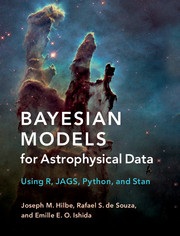Book contents
- Frontmatter
- Dedication
- Contents
- Preface
- 1 Astrostatistics
- 2 Prerequisites
- 3 Frequentist vs. Bayesian Methods
- 4 Normal Linear Models
- 5 GLMs Part I – Continuous and Binomial Models
- 6 GLMs Part II – Count Models
- 7 GLMs Part III – Zero-Inflated and Hurdle Models
- 8 Hierarchical GLMMs
- 9 Model Selection
- 10 Astronomical Applications
- 11 The Future of Astrostatistics
- Appendix A Bayesian Modeling using INLA
- Appendix B Count Models with Offsets
- Appendix C Predicted Values, Residuals, and Diagnostics
- References
- Index
- Plate section
Preface
Published online by Cambridge University Press: 11 May 2017
- Frontmatter
- Dedication
- Contents
- Preface
- 1 Astrostatistics
- 2 Prerequisites
- 3 Frequentist vs. Bayesian Methods
- 4 Normal Linear Models
- 5 GLMs Part I – Continuous and Binomial Models
- 6 GLMs Part II – Count Models
- 7 GLMs Part III – Zero-Inflated and Hurdle Models
- 8 Hierarchical GLMMs
- 9 Model Selection
- 10 Astronomical Applications
- 11 The Future of Astrostatistics
- Appendix A Bayesian Modeling using INLA
- Appendix B Count Models with Offsets
- Appendix C Predicted Values, Residuals, and Diagnostics
- References
- Index
- Plate section
Summary
Bayesian Models for Astrophysical Data provides those who are engaged in the Bayesian modeling of astronomical data with guidelines on how to develop code for modeling such data, as well as on how to evaluate a model as to its fit. One focus in this volume is on developing statistical models of astronomical phenomena from a Bayesian perspective. A second focus of this work is to provide the reader with statistical code that can be used for a variety of Bayesian models.
We provide fully working code, not simply code snippets, in R, JAGS, Python, and Stan for a wide range of Bayesian statistical models. We also employ several of these models in real astrophysical data situations, walking through the analysis and model evaluation. This volume should foremost be thought of as a guidebook for astronomers who wish to understand how to select the model for their data, how to code it, and finally how best to evaluate and interpret it. The codes shown in this volume are freely available online at www.cambridge.org/bayesianmodels. We intend to keep it continuously updated and report any eventual bug fixes and improvements required by the community. We advise the reader to check the online material for practical coding exercises.
This is a volume devoted to applying Bayesian modeling techniques to astrophysical data. Why Bayesian modeling? First, science appears to work in accordance with Bayesian principles. At each stage in the development of a scientific study new information is used to adjust old information. As will be observed when reviewing the examples later in this volume, this is how Bayesian modeling works. A posterior distribution created from the mixing of the model likelihood (derived from the model data) and a prior distribution (outside information we use to adjust the observed data) may itself be used as a prior for yet another enhanced model. New information is continually being used in models over time to advance yet newer models. This is the nature of scientific discovery. Yet, even if we think of a model in isolation from later models, scientists always bring their own perspectives into the creation of a model on the basis of previous studies or from their own experience in dealing with the study data.
- Type
- Chapter
- Information
- Bayesian Models for Astrophysical DataUsing R, JAGS, Python, and Stan, pp. xiii - xviiiPublisher: Cambridge University PressPrint publication year: 2017



